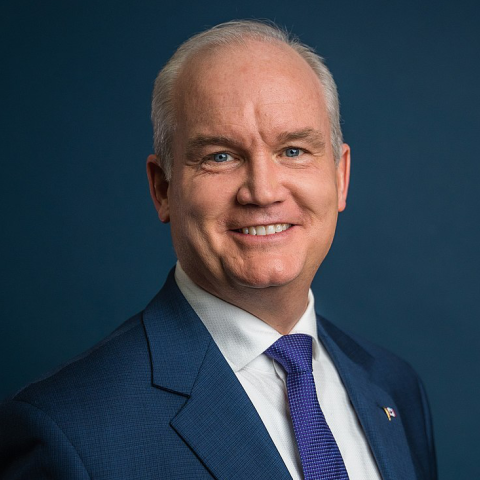
The Need for Speed: Transforming Defense Procurement for a Dangerous World


United States Representative, Third District of Alabama

United States Representative, Ninth District of Washington

Senior Fellow and Director, Center for Defense Concepts and Technology
Bryan Clark is a senior fellow at Hudson Institute. He is an expert in naval operations, electronic warfare, autonomous systems, military competitions, and wargaming.
The United States faces the most dangerous security environment since World War II. China’s military buildup, Russia’s war in Ukraine, Iran’s proxy warfare, and North Korea’s nuclear provocations demand that America maintain a credible deterrent and a decisive warfighting edge. But the US defense acquisition system is too slow, rigid, and bureaucratic to deliver critical capabilities to warfighters at the necessary speed and scale.
The Streamlining Procurement for Effective Execution and Delivery (SPEED) Act is a bipartisan initiative led by House Armed Services Committee Chairman Mike Rogers (R-AL) and Ranking Member Adam Smith (D-WA) to overhaul the Pentagon’s broken acquisition system. Rather than working around systemic constraints, the SPEED Act tackles defense acquisitions challenges head-on by cutting red tape, accelerating timelines, increasing competition, and empowering decision-makers.
Join Hudson Senior Fellows Bryan Clark and Dan Patt for a discussion with Chairman Rogers and Ranking Member Smith about the SPEED Act and why fixing defense acquisition and reviving the defense industrial base are essential to meeting America’s national security challenges.
Event Transcript
This transcription is automatically generated and edited lightly for accuracy. Please excuse any errors.
Bryan Clark:
Welcome to the Hudson Institute. I’m Bryan Clark, I’m a senior fellow here at the Institute and I’m director of the Hudson Institute for Defense Concepts and Technology. We’re very happy to have you both here in person as well as online today for an event that’s going to address one of the most important challenges the Department of Defense faces right now, which is how to get capabilities out faster to the warfighter. This has been a longstanding challenge for the department. We’ve had problems with being able to acquire capabilities, innovate at scale, provide adaptability to the force ever since probably the end of the Cold War. But certainly those problems have become much more urgent now that we see the threat increasing from China as well as the challenges posed by countries like Iran and Russia for our European allies. So being able to field a military that has the capabilities that are relevant and can be delivered at the scale they need is going to be essential for the Department of Defense.
And so Congress has done some actions over the last decade to try to improve acquisition reform, but they really haven’t gotten at a lot of the root causes that really bedevil the department of being able to field capabilities faster and more relevant. And I think our speakers here today are going to help us look at the latest effort here and one that’s probably going to be the most effective at getting at some of the root causes behind these problems. So we have with us today chairman of the House Armed Services Committee, Mike Rogers, from Alabama, as well as ranking member of the House Armed Services Committee, Adam Smith, from Washington.
And we’re looking today to have a discussion about their new Speed Act, which is going to address some of these root problems behind requirements and acquisition development inside the Department of Defense. So if you’ll join me in welcoming them here today. Well, Chairman Rogers, Congressman Smith, thank you for being here today. We appreciate it. And just to start off, Chairman Rogers, can you talk a little bit about the Speed Act. What is it that we’re trying to do with the Speed Act in terms of I approving DODs acquisition projects?
Mike Rogers:
Well, it’s not news to anybody that’s familiar with the Defense Department that acquisition processes have been glacial in pace and overly expensive, inefficient and just broken, and our position has been that the only way to fix that is to really make it the focus of what we’re going to do for an entire year. And that’s what we’ve been doing, is we’ve led up to building this in DAA, is make acquisition reform a, well, first of all, replace it. We’re not trying to fix it, we’re trying to replace what they do in the defense department with something that is more commercially comfortable to interact with, but also hopefully inviting to more participants.
What really made me more excited about doing something to see for the first time in 15 years the tech industry on Silicon Valley is interested in working with the Defense Department, and that industry moves very fast. And so they found this just foreign, trying to interact with the Defense Department. So I don’t want to let this opportunity get by as to where we don’t bring this new exciting technology into Defense Department. So if we want them in, we got to fix it, so I just think that it’s time for us to take it on. Adam and I both see this very similarly, we work very well together, and we have no problem making people mad. And it’s going to make some people mad for us to do things differently.
Bryan Clark:
That’s a superpower if you’re in Congress, is to be willing to do that.
Mike Rogers:
We’re both really good at it too.
Bryan Clark:
Yeah, so Congressman Smith.
Adam Smith:
Sure. Yeah, I think chairman summed it up fairly well, but we have several significant challenges right now, one is the rapid pace of innovation. New technologies are coming on board very quickly. You see it in the fight in Ukraine and elsewhere, drones, counter drones, missile, missile defense, secure communications, new things are being invented day in and day out that are crucial. You have to be able to field new capabilities quickly, more so now than I think at any point in human history. It’s always been important, but now it’s more important because of the rapid pace of technology. The Pentagon’s ill-suited to do that. There’s a whole bunch of different examples, and I’m going to get some of the numbers slightly off here, but I remember back in, I think it was 2004, we decided that we wanted a new communications radio basically for the Army.
So they put together a program of record, this was what was called Jitters, and started in 2004. We did not get initial rate production on that handheld radio until 2013. It took nine years to make a radio, and you just can’t have that in the modern era. So what we’ve done in this bill, well why? Too many decision makers, too much process, too many requirements is the quick summary. So all of that has to be focused down and reduced so that you can make those decisions more quickly. A second big problem we have is scale, as we’ve seen with some of the critical munitions and other things. How do we make more stuff more rapidly? We have to again, eliminate all the process, make those decisions more quickly because we’re going to need, gosh, certainly missile defense, but drones, all of that stuff to be produced in mass very quickly, not over extended periods of time.
And I guess the third problem would be money. I tend to obsess about the finite nature of resources, a lot of people don’t. It’s like, we need it, just give us the money. But we actually do have a finite amount of resources so we can’t afford to have programs like the Jitters radio or the F-35 that go on for 25 or 30 years and go way, way over budget, we’ve got to start making choices more quickly. So we want to empower people to make those choices. Now, they’re certainly going to make mistakes along the way, but better to make mistakes short term than drown the whole thing in process so that there’s simply no way to do it quickly, efficiently, and effectively. And I’m optimistic, we have bipartisan support. Chairman has been driving this certainly in the committee in the House, but crucially also with the Senate, so we’re pretty close to on the same page with them, and we’re working on the appropriators as well. So I think we can make a big, big step on this this year.
Bryan Clark:
I want to introduce my colleague, Dan Patt, who I’ve failed to introduce before. Dan’s recent report, Required to Fail, gets at a lot of these issues, so I recommend everybody take a look at it. He won’t promote it himself, so I’ll promote it.
Dan Patt:
All right, thank you, Bryan. Mr Chairman, as you highlighted, we collectively have been at this acquisition reform thing for a long time, many decades, and yet the Speed Bill really stands out in several aspects. The thing that stands out most to me is its titular focus, it’s focused on speed. I don’t ever recall a time in acquisition reform where that has been the central focus. We’ve looked at accountability, sometimes we’ve looked at streamlining and bypasses, but never the singular focus on speed. And I think that’s really notable, and I was wondering if you could share maybe some of the background. Is it looking at China’s advances or the conflict in the Ukraine? What are some of the things that really motivate this focus?
Mike Rogers:
Well, it’s been a problem for a long time and it’s just driven me nuts that it takes so long to do small things like Adam just described on that radio. So I was very focused on speed simply because the commercial sector can do it, why can’t we? In fact, that’s what got us really focused years ago back in ’13, ’14 on what was going wrong with space. I kept having all these different companies that deal with this Air Force on Space Mission saying nobody can make a decision. It takes six or eight years to get a satellite up. In the private sector it takes 18 months. So that’s when it first started bubbling to the top for me. But we’ve just heard more and more of it from folks saying that nobody, that the process is too slow. And I quote this all the time, but there’s a movie called Pentagon Wars, if you haven’t seen it, that we had everybody on the committee go out with us to Austin to talk about acquisition reform and show the movie.
But defense acquisition professionals are required to see it as part of their training because it’s about the Bradley fighting vehicle, it really happened. It’s a movie that’s a comedy about how ridiculous it is trying to do business with the defense department. This is a platform they started in the Johnson administration, it didn’t go to production until the Reagan administration. But that process that caused that is still there, the requirements process is what really created that. So those are the things that motivated me, that we all know this is broken, so we got to fix it. What we have done in the years leading up to this is we’ve given them all kinds of authorities to do different, and they just won’t, because it’s cultural, which is why we have to break the system and mandate the things that we’re going to do going forward.
Dan Patt:
Mr. Smith, another aspect of this bill that’s really striking is it goes into Title X, the part of the US code that says, hey, this is the purpose of the acquisition system, and pillar one of your bill is it rewrites that purpose and it focuses on operational outcomes. And of course, it might seem surprising to some that that wasn’t already the focus, that was not. Do you want to talk a little bit about some of the motivation behind that focus and pillar one of your bill?
Adam Smith:
Sure, I’d be happy to, it’s a cornerstone of my life philosophy. You have to have a problem-solving mentality instead of a process mentality, and there is something that’s a fundamental different way of looking at the world. Process mentality is basically we’re going to set all the systems up in place to make sure that the system runs properly and you’re focused on all of that and you always lose track of, okay, what is it that we’re trying to accomplish here? I was really struck, I went out to the Hoover Institute in Stanford and I met with their Hacking for Defense Program and met with some students who, they did this great thing with undergrads where they give them a real-world DOD problem and say, go solve it. And every class we met with said the first thing they did was they said, “You’re asking the wrong question. What you’re asking us to do is not really what actually needs to be done,” and they go in and they fix it.
Whereas in the Pentagon world, you just picture the book and go, that doesn’t make any sense, but it’s what they asked us to do, so we’re just going to keep doing it. I always use the analogy from The Office show where Michael drives into the lake because that’s what the GPS was telling him to do. We’ve just taken human thinking out of it and said, well, as long as you follow the process, it doesn’t matter if the whole thing fails because then you’re clean, as opposed to, no, I want to get it done. This is what we’re trying to do. So number one, pick the goal. What is it that we’re trying to do? And you have to have a robust conversation about that because it’s not as obvious as it may at first seem.
And then, okay, once you figure out what you’re trying to do, then you want to build in maximum flexibility to get there. And ironically, I know Elon Musk has become problematic in a variety of different ways, but once upon a time he was just a guy trying to build a rocket and he approached it from the standpoint of, I want to get here, and he said, with a great sentences, assume that any requirement is stupid until proven otherwise. And that’s an entirely different mentality than sending someone in to think, okay, here’s the book. I want you to read through every single one of these requirements and make sure that you following every single one. Instead, okay, that’s an interesting book, here’s what we’re trying to do. So it’s just a fundamentally different way of looking at the world. It is not without risk, and I want to be clear about that.
As we know, Elon Musk has blown up a lot of rockets, but it is ultimately what’s going to work if you have problems with some urgency attached to them, and I believe that we do. So that’s the fundamental change, in just shifting that mentality. And I’m always trying to find a way around the rules. It’s like, this is where I want to be. Well, no, you can’t get there because of this, and I’m like. Even driving here today, we were heading down Independence Avenue. Independence Avenue was backed up to High Heaven, so we said, well, let’s just drive across the capitol, which you wouldn’t have ordinarily done, what the GPS wasn’t going to do, and so we got here on time. You got to have that, I’m trying to get here, and don’t tell me that I got to do all this crap. Let’s get there. And in our bill we want to try to change that. And by the way, it’s not just the Pentagon, Congress has this problem as well.
Mike Rogers:
Exactly right.
Adam Smith:
We love our process. We love being able to say, I am the one who put in place this piece of legislation that is required, blah, blah, blah. Okay, well that’s great, but we’re getting in the way of getting the job done. So it’s a fundamental shift in mentality that is needed at the Pentagon, it’s needed at Congress, and it’s also needed amongst the contractor base. Now, mostly with the contractor base, they’re a little bit more practical, their focus is on making money. And they’ve been making money just fine off of this clearance process, so we got to shift those incentives so that they are incentivized in different ways.
Bryan Clark:
So chairman, one of the challenges that will arise here is getting acquisition leaders to feel the agency to be able to act and take advantage of the authorities they provide. They already don’t do it, they already don’t use the acquisition authorities they’ve been given.
Adam Smith:
Yeah. And if I could, that’s what’s so crucial about this, and this is sort of the way I feel about the federal workforce. I think the federal workforce is incredibly capable. We just set up a system of rules that make it impossible for them to do their jobs. I mean, we’ve just told them, I mean, someone at the procurement office can be sitting there going, “Ah, this is what we need to do.” Oh, nope, sorry. You cannot do that.
And then we’re crippling them. We’re not empowering them to use their talent to get to a place. And I think, I mean certainly, some people are better at things than others. Then we need to make those types of judgments, pick the people that are good. But I think in a lot of cases, you’ve got people who could be so much better, if you would just empower them.
Bryan Clark:
Right. And I think the thing that shackles a lot of acquisition folks is the requirements process. They turn to the headquarters people and say, “Well, I can’t do this unless the headquarters people say it’s okay.” So when we implement this new approach, and we focus on outcomes, and we focus on problem solving, it’s going to give the acquisition side, PEOs in particular, a lot more freedom.
And the bill affords them a lot more authorities and agency to really act as the true problem solvers. Is one of the problems or challenges we’re going to have, is getting those folks to get in the right mindset? Because they’ve been so used to operating inside of a process structure for so long now, that to act more independently might be challenging for them?
Mike Rogers:
Well, they’ve just got to understand that we’re not looking for a no-risk situation. And that’s going to require us to change, too. Congress can’t be pouncing every time they try something and fail. Because failing is the way you learn. Adam made the point, “Elon Musk has blown up a lot of rockets. He’s learned every time. And now he’s doing things that nobody thought was possible.”
Kim Jong Un blew up a lot of rockets. Now he’s got one that can reach the United States. Failure can be, and is, a way to learn. So, Congress has to change its behavior, too. But we want to incentivize that. Which is why we’re empowering acquisition professionals, PEOs, in this legislation.
Most people want responsibility and the power to do things and make things happen, and be rewarded for it. And we think this system sets that up. We are trying to send the signal that we are going to not reward people who are risk-averse and are trying to be bureaucratic in their processes.
But I think that the way we’ve structured this, it’s going to not just incentivize, but push PEOs to move in a different direction. And I think they’re going to be much more fulfilled in their jobs. And that’s what we’re hearing from them. Because we’re talking to them, too, about what they want changed. It’s going to be incumbent on us as we move into this, that we reward risk-taking as a part of our future activities.
Dan Patt:
So, one part of your bill, the second pillar that I’d like to draw you out on, is in the requirements process. And for everyone here, our current joint requirements process, it’s known as JCIDS. Like everything in the DOD, we love a good acronym, our joint capability integration development system. It’s been around a while, since like 2003. There’s been a whole bunch of little tweaks to it.
One of the really interesting things about your bill is, you don’t just ask the department for tweaks to it. You actually direct some real changes to it. And some of the things that stand out to me in your stated approach are, one, the desire to focus on problems and problem solving, connected to war fighters, including our combatant commands. So, like INDOPACOM, for example, who own these war fighting problems.
Two, the focus on not just requirements, but thinking about, how do requirements lead to resourcing? Not only do I have a problem to solve, we need to move some money around these problems.
Can you share with us, Mr. Chairman, some of the thinking behind some of these larger, more significant changes to the joint requirements process? Why not just ask the department to improve it, but actually to go in there and really reimagine this process in the bill?
Mike Rogers:
Because of what Adam said a little while ago. We don’t want them to have to follow a preset requirements package that is not focused on this particular problem. We want to get after the problem.
One of the things that’s happened recently that spurred our focus, is companies like Anduril. Where they came and said to the DOD, “Tell us a problem that you want gotten after.” And then they went and spent their money on research and development, to come up with a solution to try to fix . . . That’s what we want to create. We want to create an environment where people do that.
I went out to the West Coast and talked with venture capitalists on different trips, and what they were saying, was basically there is an enormous amount of capital in the private sector that will take care of your research and development, if you’ll just buy stuff without putting us through a requirements process after we get the award.
And they made the point. They said, “And we will do it. We will do the research and development repeatedly, even if we don’t get the bid, if we just know you’re going to buy stuff. Because we know we’ll ultimately win one at some point in time.” That kind of thinking is what really inspires me.
Because Adam’s right. We have a finite amount of resources. We spend an enormous amount of money on research and development that we don’t have to spend, if we’ll let the private sector do it. But going to this requirements question that you started with, once we do an RFP, and we get a potential solution that, let’s say, is 75 percent an answer. We need to award that bid, maybe change it just a little bit at the beginning, to try to get it to a 80 percent solution, but then buy it.
And if we want to work on the other 20 percent problem, we can do that in a second request. But if we will do that, and do it quickly? It will bring a feeding frenzy to the department.
Dan Patt:
Yeah, this focus on iteration really stands out. Mr. Smith, another feature of your bill related to requirements is, it sets up this rapid directorate, right? So, it aims to cut this requirements timeline down to 90 days, or less. But it also seeks to align acquisition, align requirements, and align dollars, resources.
And of course, I think that’s a really interesting focus, to try to get all of that alignment early and upfront. Can you talk a little bit about some of the motivation for that kind of alignment and collaboration?
Adam Smith:
Sure. I think the motivation is speed, as we’ve said. We want to get there quickly. And I think the way we’ve done it is, and to the chairman’s point about going to more rapid procurement, DIU has been very successful, in the sense that we have given a place for people with innovative technologies to go, get some money, and do R&D.
But where it has run into trouble is what the chairman pointed out is, okay, we decide we like something, and then it takes two to three years before we buy it. So one thing this bill does, is it brings DIU and the procurement process closer together, so that they are empowered to make quick decisions, that once they develop that technology, then they can buy it.
Because that’s the issue with, if you’re in this business, the best answer is yes, the second best answer is no, the worst answer is maybe. And once we get to the point where you know if you make this investment, to the point the chairman just made, that we’re going to make a quick decision. Even if you lose three or four, it’s fine. Okay, we’ll go back and do it.
But if you know that even if you get it right, even if you get the thing that they want, you then, you might die before they actually buy it, metaphorically. Capital-wise. Though in some cases . . .
Mike Rogers:
That’s right.
Adam Smith:
. . . it takes even longer than that. I wonder if the guy who first came up with the F-35 concept is still alive.
So, we speed up that process. And then what happens is, what the chairman just said, you get your Andurils and Palantirs, and innovative companies that come in and say, “We’ll go do it. And we’ll keep doing it, because we know that if we hit one out of five, one out of six, one out of 10, whatever, we’ll do well.”
So that’s the purpose of it, is to shrink that down, and a really closer connection. And then you will get those investments, you’ll get better decisions, and you’ll get to a better place.
Bryan Clark:
So it seems like what this does, is it fundamentally changes the objective of the acquisition process, from achieving a certain set of performance objectives, like it has been under the requirements-driven process. This thing’s got to do a certain set of things in a certain set of ways. To, “I need to achieve. I need to solve the problem. I need to do it in a given amount of time at a certain scale.”
Adam Smith:
Sure, yeah. And the hope is that that changes your mentality a little bit in terms of, again, focused on problem solving. And I’m sorry, Tyler, I’m going to use something that only you are going to appreciate.
So, a Mariner’s analogy. Mariners have been coming close to the playoffs for the last four or five years, made it once, and not really got there. And our GM at one point, explained that his philosophy was, because he was never making the investments at the time they needed, to make the trades.
He says, “Well, look. I figured out that basically if you get your baseball team to the point where you win 54 percent of the games, you do that often enough, eventually you’ll stumble your way into the playoffs, and you’ve got a chance to win.” That’s not the way he put it exactly. But I’m like, and I get it, but that’s the thing. This is not understanding what the objective is.
So, in his mind, it’s like, “Okay. If I win 54 percent of the games, if I build a solid organization, then I’ve got a pretty good chance to win.” That’s all true. But there is a difference between winning 54 percent of your games, I’m trying not to swear here, and winning. Okay? And that will change the decisions you’re going to make. At which point, I could go all geeky on a couple of trades that they made, that show why those trades were made to win 54 percent of the games, which shouldn’t have been the goal.
The goal should have been to actually win. And if you start thinking that way, it changes your processes, it changes your approach. So we basically have a Pentagon built around the concept of, “We’re all going to try to win 54 percent of our games.” And then we sit around and go, “But, damn, we never seem to actually win.” Well, maybe we should go ahead and change the goal? And then that changes all kinds of decisions back over here, that then get you to a better place.
Bryan Clark:
Right. Which is a very different way of thinking about acquisition, for the acquisition side of the house.
Adam Smith:
It’s not just process, it’s a mentality that we’re trying to change.
Bryan Clark:
Right. But you can certainly incentivize that.
Adam Smith:
Blowing up the system, instead of tweaking it.
Mike Rogers:
And that’s the thing that people have to understand, what he just said. “Blowing up the system instead of tweaking it.” We are not just trying to reform the old system. We are replacing it, and putting timelines in, that require them to act within a short amount of time, and make decisions, so that it is not possible to drag this thing out, and continue what we’ve been doing in the past. So, this is a fundamental shift.
Bryan Clark:
Yeah. Because if time is your main objective, or your main limit, then you’re going to achieve the 75 percent solution, whatever percent you can get in that time. And then that’s successful, as opposed to 100 percent.
Mike Rogers:
Perfect cannot be the enemy of the good, or the very good. And it has been. The department is completely risk-averse, and that’s insane.
Adam Smith:
And perfect contemplates, like I said, okay, we’d love to be able to do all of this. Sure. What do we really need to do? What is most important right now? And let’s go do that. And that’s a different way of looking at it, as well.
Bryan Clark:
And so, Chairman, it seems like a lot of the reason we can move in this direction maybe is also the availability of technology. The fact that we can get an Anduril to go take advantage of commercially available technology, build a system that’s militarily relevant, get it out in a relevant period of time. We maybe couldn’t have done that 20, 25 years ago, when the first folks developed JCIDS.
Mike Rogers:
It would not have happened then. I’ve been in Congress 23 years on this committee. They were not remotely interested in dealing with the Defense Department in the first 10 years I was on this committee. That started changing in part, because some companies started seeing some success.
But also what’s happened in the world has inspired . . . I mean, they’re patriotic Americans. They’re upset about what’s happening. And so, there’s a lot more excitement about helping the Defense Department now. But also working with it, because they are seeing some companies, like Palantir and Anduril, that are being successful.
And I don’t want to let that get away from us, because they can get frustrated and go, “Screw this. I need to go in a different direction. This is not worth my time and energy.” That also gives us a sense of urgency to do this now, because if you look at what’s been happening, well, for a while with unmanned platforms, but specifically in Ukraine? Technology is a game changer in war fighting.
And if we can get ahead of our adversaries and potential adversaries in developing artificial intelligence, quantum computing, all the things that are going to be a part of our future weapons systems, it can keep us in a dominant position. But it’s going to take the changes we’re talking about to bring that capability and that world in to the Defense Department. I guarantee you, if we don’t fundamentally change the way we buy stuff? They will get tired and move in a different direction.
Adam Smith:
And innovation happens in a bunch of different climates. I think it was in the UAE there was like an air base, and we have people there who are working on drone problems. And they’re making their own drones, just like the Ukrainians are doing. They’re cranking out a million drones in garages and shops and everything. And these are just smart warfighters in the front end coming up with ideas and solutions right there that we’re not really able to implement right now. We got a whole bunch of rules and regulations restricting what they could do. And then even if they come up with something great, it’s like, well, we’ll start you in the process. We need to empower the war fighters too, who are out there coming up with solutions and make sure that we can implement those solutions quickly and at scale.
Dan Patt:
Well, that’s a really interesting part of your bill. There’s this emphasis on experimentation. So one way of thinking about the legacy requirements process is it really put the burden on the Department of Defense to try to predict the future. What are our future threats? And eventually you need to get to specifications that acquisition can run with and put on contract. And here in your bill, there’s much more an emphasis on problems to solve. We’ve talked about that. Much more of an emphasis on iteration. We’ve talked about that. And part of what your bill does is it sets up, has a department set up an experimentation activity, mission engineering integration, experimentation. And I assume that some of the motivation is around what you just said, Mr. Smith, about not just technology, not just the tools, not just drones, but also how our war fighters use them. It is how we fight not only what we fight with. And my interpretation of that experimentation section is it’s about this co-discovery, figuring this out as we go and iterate. Is that the intent there?
Adam Smith:
Adaptability. I mean, Bob Gates had this quote in front of our committee years ago that basically . . . What is it? We’ve never been right predicting what was going to come next was his point. And there’s a lot of different ways to interpret that. Some interpreted it as that means we have to do everything. But the way I interpreted it was there’s really no way to be right. The future is notoriously difficult to predict. So what you need, you can imagine that, okay, well then I’m going to anticipate every possible conceivable variation of the future, and I’m going to prepare for it. I think that would be monumentally stupid in my opinion because you’d spend yourself into the ground. You’d never get there. What you have to do is you have to build a system that is adaptable, that can quickly move and change and say, okay, that’s what happened.
Let’s go. Let’s get ready. And we have the exact opposite of that system right now. We have the least adaptable system that I can imagine. So what we’re trying to do is to speed up the process and make it adaptable because you’re right. We don’t know what’s coming. Who could have predicted the way the war is playing out in Ukraine right now? I mean, the day Russia launched that war back in February of 2022, who would’ve predicted that we’d be... I’ll tell you. Literally nobody would’ve predicted it would’ve played out the way. So you need to be ready to be adaptable and make changes and adjust to the circumstances that come.
Bryan Clark:
So Chairman Rogers, one of the things that might be necessary to support that kind of adaptability is investment in the infrastructure for innovation. Test ranges, training ranges, digital infrastructure. So you can do a lot more of this operational innovation, this co-discovery that Dan’s talking about in a virtual environment. There’s some money in the reconciliation bill that goes towards things like that. But are we going to have to make a more of investment in the DOD being able to create a sandbox for folks to come in and demonstrate and experiment as opposed to this being something that they have to do themselves.
Mike Rogers:
They can’t take it out of hide. We’re going to have to provide them with the resources they need to do this. And we’re prepared to do that. We recognize we’ve got challenges economically that we got to get after. We debate how much more we have to spend, but we know we got to spend more to make this happen. And I also want to point out that in this legislation, we are really putting a lot of focus on the value we put on acquisition professionals, not just with those kind of resources, but the kind of people we want to bring in and also how much power we’re going to give them because we want them to feel valued, and it’s going to require . . . A lot of y’all know I’ve been very focused on the space force. I want people, I want acquisition professionals in that service to be seen as just as important as any operator.
And that’s just not historically been the case. So things like this legislation are going to change that. And I think that that’s going to help us draw the kind of people we want into that, but also help them flourish professionally.
Bryan Clark:
I mean, I would think you’d want the acquisition professionals to be the people overseeing or even leading the experimentation effort, right?
Mike Rogers:
Absolutely.
Bryan Clark:
Just like a product manager might be at a tech company where they’re leading the operational and technology sides of it, not just kind of waiting for the operators to come up with the problem to solve.
Mike Rogers:
I want the best and brightest to see that as just as important a career choice as becoming an operator. And right now it’s just not been seen that way. And also they find their career very frustrating because they’re so bound to these constrictions that Adam talked about.
Adam Smith:
I want the acquisition folks to interact more closely with the operational folks. I’m going to get all the terminology wrong here, but this is something again that SpaceX really focused on. Having the engineers on the floor, working with the people who are actually instead of up here then saying, “Well, why don’t you do . . .” Bring those two together. They ultimately have to work together to get to the best solution.
Bryan Clark:
And it seems like things like creating more environments, more sandboxes for innovation, it will cost some money. But I think to your point, Congressman Smith, that this will also help reveal things we don’t want to invest in. There’s going to be things that we’re spending money on now that we probably could do less of or not do at all because they don’t solve operational problems. So the investment we’re making here in being able to have a more flexible requirements and acquisition process could also allow us to kill things that are bad investments. So there’s savings that could be achieved there.
Mike Rogers:
That’s exactly right. And they’re going to have discretion to move money around themselves without having to come back to us.
Adam Smith:
Will kill things, but also crucially build things more quickly and less expensively, okay, to not get trapped in that endless circular process and just go, “Okay, this is what we’re doing.” And go. So even if you’re not killing it, you save money because you get it done more quickly.
Dan Patt:
One notable part of your bill is the effort that it goes to to reach out to a broader industrial base. It opens up other transactions agreements, so other mechanisms to get industry on board. It changes thresholds, and there’s a real focus on, I guess, a broader industrial base. Mr. Chairman, can you talk a little bit . . . I think a lot of us have sort of seen these charts about the number of prime contractors dropping and we have the impression there are fewer companies doing business with the Department of Defense. Why do you have this apparent optimism that now is a moment when maybe this can broaden up? Why are you trying to reach out to more companies?
Mike Rogers:
Two reasons. One, I just talked about earlier, that’s the tech industry wanting to get in. But second is we have allowed our defense industrial base to atrophy to a level that is constricting our opportunities, our ability to meet threats. And Adam knows, I’ve been talking a lot about we got to get our defense spending increased dramatically. We’re at the lowest level of defense spending as a percentage of GDP since before World War II, 80 years. And so I’m pushing for big increases in defense spending so that we can get after things like Sentinel, like the nuclear submarine problems like Golden Dome, a whole host of challenges, not to mention quality of life for our service members. We just don’t have the resources to get after all those. But here’s the problem. Let’s assume that we’re successful, and we’re able to get defense spending from the current 2.9 percent to maybe 4 percent.
The problem is the last time we had that kind of increase in investment in defense in this country was in the eighties under Reagan. At that time, we had 51 prime defense contractors. We now have six. We’ve got to find a way to encourage more companies to get in because let’s say that we can get our defense spending up to 4 percent. You got to take that money and turn it into goods and services. We don’t have the defense industrial base to do that right now. So it’s going to require an expansion. It’s going to require a scaling up to those that are already there, and we have to incentivize that. And I think this kind of change in acquisition will be inviting enough to encourage more participants to get in and hopefully we can then do things because this is going to be an evolutionary process. This is not a one-off what we’re doing this year.
Next year come and layer on some more things that we think are necessary that will help take a midsize contractor and help them grow to a larger contractor. But we cannot meet the challenges that we face as a nation from a defense standpoint with our current defense industrial base period.
Adam Smith:
I think one of the reasons I’m optimistic is put the Pentagon aside for the moment. Just in general, the barriers to entry for companies are so much lower now than they used to be because of technology. You can innovate more quickly. You have more access to information through the internet. AI is developing, so you can have companies, certainly you’ve got the Andrules and the Palantirs and some of the bigger ones. But what I’ve really been struck by is particularly the area of space and autonomous vehicles, there are dozens of companies all across this country. I do a quick shout, a company called Mock, which some really, really insanely young person started that builds autonomous vehicles. And they’ve also working on a supersonic missile or hypersonic missile, sorry. And just some kid came up with an idea. He was able to get access to a limited amount of capital and boom.
And you’ve got dozens of those in the space area, Tokyo, all that. So they’re out there developing these technologies that have massive commercial applications. And what we’re trying to do now is reduce the barriers to entry so that they can get in and start working with the Pentagon. And part of the innovation process on that too is getting past the vendor lock issue, making sure we maintain the competition so we can teach even the big companies that the way to make money from the Pentagon is not the old system, which is rig the requirements process, get the contract, lock it in so that they got nowhere else to go. Instead, you’re going to have to compete, and you can compete for a lot of different things. You get in and out, you’re going to be able to make money, but that old way of doing it is going to be dead, so we can get to a quicker, more innovative approach.
Mike Rogers:
Yeah. Let me mention something that came up when we invited defense contractors to come in and talk to us and just give us ideas. We invited primes. We invited traditionals in a separate panel. We invited non-traditionals in separate panel, different folks to give us feedback. One of the things that came out of that that I never considered, but it was consistent among all of them, if you will change the accounting system to GAAP accounting, A, they said you will take 10 to 15 percent off the cost of every contract because we don’t use the Defense Department accounting system for anything other than the Defense Department contracts. So if you have a company, let’s say that historically doesn’t do work with the Defense Department and they win, they then have to set up an entire set of infrastructure, hardware, software professionals to do the accounting for just that contract when that may only be 20 percent of their business. And their point was, all of us use GAAP accounting, just let us use GAAP accounting.
So guess what we’re going to do? Let them use GAAP accounting, and it’s going to make it less expensive, less difficult for them and save us some money. There will be some legacy systems that we’ll continue to use the current accounting system, but those are the kind of simple no-brainer things that we just haven’t been doing.
Bryan Clark:
Yeah. And that’s one of the barriers that if you’re a prime, you take advantage of that because you’ve got the infrastructure and the wherewithal to be able to do that.
Adam Smith:
That’s what I was trying to say.
Bryan Clark:
Right. Right. There’s a lot of moats that these folks can put in place now. So for the primes, for these big companies that have been the defense suppliers for decades now, how are they going to have to change to be able to work in an environment where they now are solving operational problems instead of driving requirements towards the things that they are already developing or already have developed?
Adam Smith:
It’s always been my opinion that it won’t be hard. They’ll just have to compete in a different way. I’ve always said that it’s not that the large defense companies can’t compete and innovate. It’s just that they’d rather not. They’d rather just, “You give me the contract and I keep getting paid and we keep things where they’re at.” There is plenty of smart people at Boeing and Northrop and plenty of them and plenty of innovation. They got research and all that. Once you shift that, I think they will be competing. They will still be major factors in what we’re doing. They’ll just now be competing with a broader range of people, and I think they will help us in a whole bunch of different ways as well.
Mike Rogers:
Yeah, and Lockheed for example, I’m thinking about. They were one of the main companies saying, “You need to change the GAAP accounting.” I mean, they’re as big a defense contractor as you get. But if we can simplify their life where they can take this infrastructure and use it for commercial competition as well as defense, that’s good for them. Don’t get me wrong, there’s some things that we doing that give them advantage, but they’re not going to be as resistant to these things as some people think because it’s got benefits for them by moving to a more commercial enterprise as well.
Dan Patt:
I want to make sure that our audience recognizes just how big of a shift this bill represents for the department. And one of the things that really strikes me as a big shift is this attempt to not just change processes and rules, but to try to drive a different culture, and you’ve talked a little bit about this. But for example, from the acquisition workforce, it feels like you’re saying we’re going to demand speed, we’re going to demand accountability, we’re going to demand mission outcomes. You’re getting all of this autonomy. You’re allowed to trade resources between your portfolio. You’re allowed to shift the performance specifications that you need. You’re allowed to iterate. You’re allowed to fail. Tell me a little bit, Mr. Chairman about this cultural shift. How long do you think that this might take? What confidence do you have that the department and the industrial base can actually pull off a pivot after so many years of a system that rewarded a different set of behavior?
Mike Rogers:
There’ll be a little bit of a shock, but it won’t take long. The fact is the department vigorously fought the Space Force being pulled out of the Air Force and created as a second service. Within two to three years everybody was like, that was great. Glad we did it, worked out wonderful. Thank goodness, and it has just bipartisan support. It has great support in the department. It just was a painful change.
And I tell this as an example of just human nature. I’m a member of a fundamentalist Baptist church in Alabama, and in my church, if you try to change the color of the carpet or the hymnal, half the congregation wants to break off and start a new church. That carpet was just fine for my granddaddy. I don’t know what the problem with y’all is. That’s just human nature. People don’t want to change. The department’s run by human beings, and they just don’t want to change. It’s not their nature.
But having said that, once you make them change and they realize, oh, this is pretty good. When they have, they realize, look at the authority I’ve gotten now. Look at the things I can do, how much more fulfilling my job is, they’re going to be great. So I think this is going to be a two to three-year transition, and after that, people are going to be just comfortable in their new suit.
Adam Smith:
There’s one other key part to it and that is the national defense strategy because when I said the first part of this process is making sure you know what your goal is, right now, it’s my opinion that we have too many goals. We have a national security strategy that is built on the idea that it’s going to be 1991 forever, and when we were the world’s sole remaining superpower and really didn’t have much in the way of competition out there in the world. Now a strategy based on the premise that we are going to be able to fight wars all over the world and do all this stuff, we have a strategy that is impossible to achieve because it is asking us to do too much. So getting the right national defense strategy and figuring out what should be the key goals to achieving our deterrence, to making sure that we meet them, that’s going to be key.
I mean, if you come in and you have too many goals and you’re going for too much, trying to do too many different things, I think of this . . . Sorry, I’ve been working on political campaigns since I was 15, so that’s a lot of my mindset. There’s a whole bunch of different ways to send out messaging in a campaign. And one of the things I’ve figured out early on, now there’s a lot more than there used to be when I started out, but I figured out there’s a minimum you have to do in each area to be effective. And if you decide, well, there’s 10 different places, so we got to be in all 10 and you wind up doing a little bit in all 10, then you suck at all 10 and you lose. You’re better off to say, okay, these are the three that are most important combined with these are the three that we are most capable of achieving. So let us focus our objectives here and then we’ll get to where we need to be.
We’re going to have to start making some of those 30,000-foot national defense strategy decisions. So what the Trump administration, they’re going to have to do there, as every new administration does, they’re going to have to do their NDS here in the next six months, and it’s going to be real interesting to see if they make those type of choices. If they make the right choices, then what we’re doing will flow right seamlessly into making that effective.
Bryan Clark:
So to follow up, and I’ll ask you questions in a second, I just wanted to alert everybody that wanted to, I’ll turn to audience questions here in a couple minutes. If you have questions, start formulating them now and I’ll make sure we get Talia to be able to come around with a microphone. We can address those near the end of the talk.
But to follow on your point about strategy, so also that would imply that force design has an element to play in this as well. If we have the force of 1991, it was mostly big, crude, multi-mission platforms that more or less could emerge out of a long-term requirements development process where innovation didn’t have to happen very quickly, that military was stayed. And so today, that’s not the case. Our force design’s evolving and will lend itself to having faster innovation, a more diverse or heterogeneous force. Is that part of this too is that we need the military’s design to change to solve these operational problems because unless you do that, you’re not going to have the opportunity for this innovation to happen?
Adam Smith:
Absolutely. One of the key aspects of all this is what is truly survivable and what will be survivable going forward? And that’s not as easy a question to answer as you might think. There’s a whole bunch of different technologies. You can come up a counter drone, missile defense, you can come up with spoofing, jamming, cyber. So we have to figure out what is going to be survivable, and I think that’s one of the key parts to it is what investments do we need to make in which technologies that will make things more survivable and where in the world? And that’s a technological question that goes way over my head, but that’s why we hire smart people to figure those things out and make those decisions. But what we’re trying to do in our bill is to make sure that once we have those smart people, they’re empowered to make those decisions instead of being drowned in process.
Bryan Clark:
So question to the audience, if you want to ask. No questions. Sir, yes? We’ll bring the microphone around and say who you are and where you’re from.
Gary Loberg:
Gary Loberg, I’m from Monterey Technologies. We’re a small traditional defense contractor, so wanting going to go new is great, and I’m all for grabbing the technology innovation that comes with that. The question I’ve got for you gentlemen is what’s the impact of budget or fail to pass a budget, that recurring continuing resolution problem that all of us wrestle with. If you change the system and the dollars don’t flow with it, how are you going to change the behaviors?
Mike Rogers:
That’s going to be the problem regardless of whether we deal with acquisition reform. The problem that we’ve had with not getting appropriations bills passed on a regular basis has had a chilling effect on the desire for most businesses to want to get in to this world. And that’s going to be the case whether we deal with acquisition reform or not, so I think that’s a whole separate question. And I will just say from somebody who’s been here long enough, and Adam’s been here slightly longer than me, we cannot continue to let continuing resolutions happen for a whole host of reasons. We were here when the system worked, when we passed appropriations bills every year, relatively on time up until 2010 roughly is when it happened. And we’ve seen how the system should operate and we got to get back to that or we’re all going to wish we had dealt with it because this can’t go on.
Adam Smith:
Yeah, I completely agree with the chairman on both of those points. The thing I would add is we have to get at what the source of that problem is. I think a lot of people misunderstand why it is that we can’t pass appropriations bills on time and why we’re stuck with the CR. I guess some assume it’s like dysfunctional congress or too partisan. Apparently we don’t go out for a beer together often enough. And the real source of the problem is that the American people have decided that they want a balanced budget and they don’t want us to cut any spending or raise any taxes, and that’s impossible. So as politicians, we know that no matter what budget we vote for, literally there is no budget that we could vote for that would be popular. The best thing that can happen for you at the moment of a budget vote is that you get some terrible illness and you’re not in a position to vote. Because it’s just not going to be a good fit. So we have to somehow figure out how to communicate with the American people you can’t keep demanding that because it’s not possible. There’s a whole bunch of different scenarios and choices we can make about how we want to get to a budget, how close to more fiscally responsible do we want, what do we want to cut spending on, what do we want his taxes on? But we’re living in this fantasy world right now of something for nothing.
And sadly, politicians are learning that when you’re campaigning, it’s the best thing to promise. And I’m just going to go this whole we’re not going to tax overtime, we’re not going to tax tips, it’s the dumbest goddamned thing I’ve heard in forever. And, oh yeah, we got to do that. And it came from Trump, but the Democrats are like, oh, we can’t let him get out in front of us in this. We got to agree with him. I was talking with a friend of mine last night, he’s like, “Well, what I just decided is all of our, we’re going to try to convert half of our income to be overtime and tips. Okay, all of a sudden, you’re all going to have a 30-hour work week, and you’re going to be getting tips at the end of the year like you wouldn’t believe.”
And it’s like this is not a hard thing to figure out. Yes, your three-year-old would like to eat ice cream all day, but part of your responsibility is to say, yeah, no, we’re not doing that. So we’re just walking down this road of making promise after promise after promise that has driven us into the ground.
Mike Rogers:
But I want to say that even if we fix the acquisition problem, if we don’t get after the thing you just described, it’s not going to matter. We have to fix it.
Adam Smith:
Amen.
Mike Rogers:
We have to be able to operate on a regular basis and get funding bills passed. We just have to. We get to get back to that, and I’m not exactly sure how we’re going to do it. I have some ideas, but this can’t go on much longer.
Bryan Clark:
I think to close out the discussion, one question I want to ask both of you is five years down the road when we’re looking at this in the rear view mirror, acquisition reform is completed, the SPEED Act was implemented, what do you want the war fighters, the military personnel and the folks on the Hill to be able to look back and say, what do want to have accomplished? What are the outcomes you’re looking for here that are going to be the legacy of the SPEED Act?
Mike Rogers:
I want the war fighters to be able to get what they need to be successful. I want the combatant commanders to be able to say, “Yeah, when I’ve got a threat, I’ve got the ability to get what I need to get after it,” without having to wait years. It has just been a problem for decades, and I just would like for them to be able to say, “I’m able to get stuff in a relatively timely manner.” Period, that simple.
Adam Smith:
I just want here’s the idea, two years later, we got it, it’s on time, and it’s on budget. I mean, when you think about some of the programs and how long they’ve taken, I mean the tanker.
Mike Rogers:
Future combat systems.
Adam Smith:
Right, yeah.
Mike Rogers:
We never even got that one.
Adam Smith:
It just died, but the tank, so 20 years later, I would love, I think it was like 2004, 2000, so let’s say 2026, we decide we want to build something, 2029, we got it.
Mike Rogers:
That’s right.
Adam Smith:
That’s what we want.
Mike Rogers:
And again, it may be a 75 or 80 percent solution, but that’s okay. That’s the way we got to start changing the way we think.
Bryan Clark:
Well, gentlemen, thank you very much for your time today to talk about the SPEED Act. Chairman Mike Rogers, Ranking Member Adam Smith from the House Armed Services Committee, we really appreciate your time and coming out here to talk about it.
Adam Smith:
Thank you.
Mike Rogers:
Thank you.
Bryan Clark:
Thank you very much.

Michael Doran, director of Hudson’s Center for Peace and Security in the Middle East, will host Congressman Joe Wilson (R-SC) for a discussion on the strategic benefits of designating the Polisario Front as a foreign terrorist organization (FTO).


Noach Hacker, Israel’s minister of economic affairs, will join Hudson’s Michael Doran for a discussion on how Israel has fortified its economic foundations for moments of extreme crisis.


President of Kosovo Dr. Vjosa Osmani Sadriu will discuss the crucial importance of American leadership for peace and stability in Europe and why America’s role is just as important today as it was over 25 years ago.


Hudson’s Riley Walters will discuss what to look for during these exercises and what more Taiwan can do to strengthen its defense posture with a panel of military experts.






















